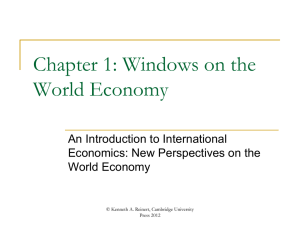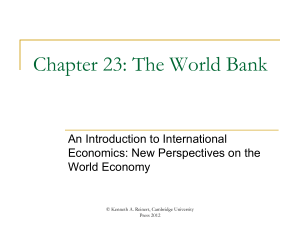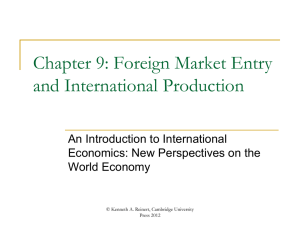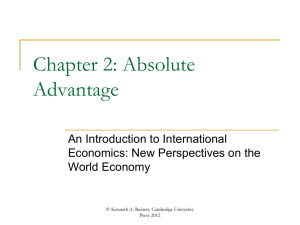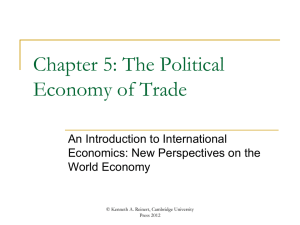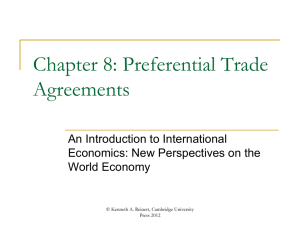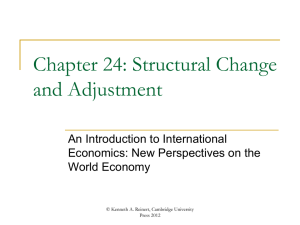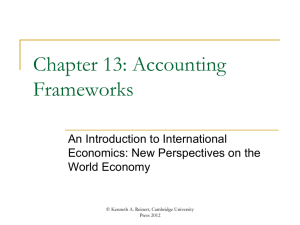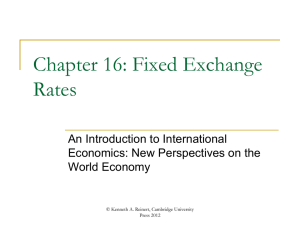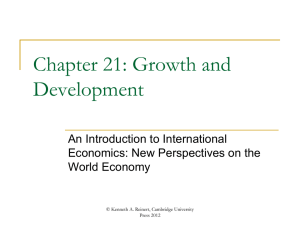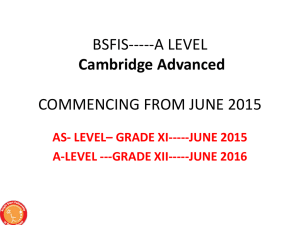Chapter 6 - An Introduction to International Economics
advertisement
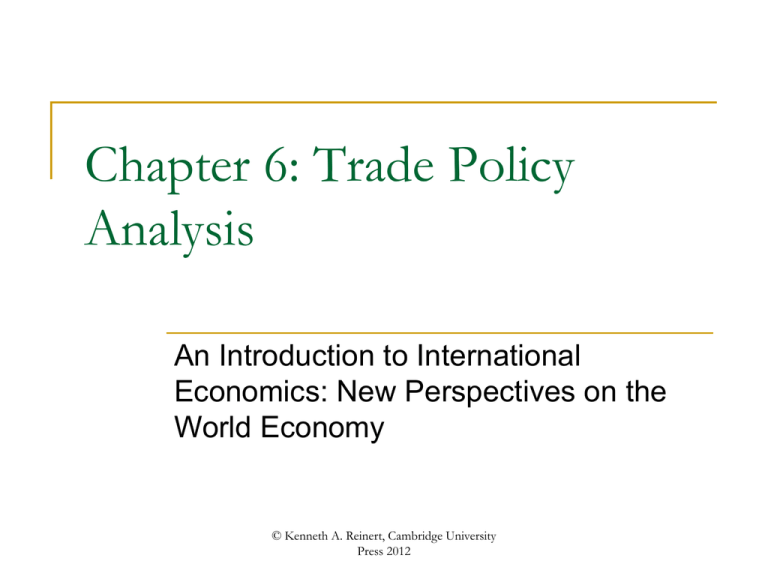
Chapter 6: Trade Policy Analysis An Introduction to International Economics: New Perspectives on the World Economy © Kenneth A. Reinert, Cambridge University Press 2012 Analytical Elements Countries Sectors Factors of production © Kenneth A. Reinert, Cambridge University Press 2012 Introduction Reasons to expect landowners in Japan might oppose the import of rice from another country Opposition to imports exists despite overall gains to Japan from these imports Trade policy analysts and international affairs professionals are often called upon to assess impacts of government interventions in international trade Purpose of chapter is to understand how the assessments are made © Kenneth A. Reinert, Cambridge University Press 2012 Figure 6.1: Absolute Advantage and Trade in the Rice Market Kenneth A. Reinert, Cambridge University Press 2012 Absolute Advantage Revisited In moving from autarky to trade in Figure 6.1, there is a reduction in domestic quantity supplied in Japan Japanese rice-producing firms would lobby Japanese government to oppose decrease in domestic quantity supplied Demand protection from Vietnam exports Protective policies are widespread in world economy Kenneth A. Reinert, Cambridge University Press 2012 Trade Policy Measures A country can grant import protection to a sector of its economy in form of either Tariffs: a tax on imports Specific tariff is a fixed tax per physical unit of the import Ad valorem tariff is a percentage tax applied to the value of the import Non-tariff measures Governments employ both types of tariffs See Table 6.1 Kenneth A. Reinert, Cambridge University Press 2012 Table 6.1: Nontariff Measures Tax-Like Measures Cost-Increasing Measures Standard and technical regulations and others Quantitative Measures Anti-dumping duties, countervailing duties and others Quotas, tariff rate quotas and others Government Procurement Practices Kenneth A. Reinert, Cambridge University Press 2012 A Tariff For our graphical analysis in this chapter, it is much simpler to consider a specific tariff Basic results also apply to an ad valorem tariff A tariff increases domestic price of imported product above world price In the case of Japanese rice, domestic price is many times larger than world price Causes an increase in Japan’s production of rice which is desired effect from Japanese rice farmers Domestic consumption of rice falls Imports fall Kenneth A. Reinert, Cambridge University Press 2012 Figure 6.2: A Tariff on Japan’s Imports of Rice Kenneth A. Reinert, Cambridge University Press 2012 Tariff Effects Welfare and revenue effects also occur from the tariff Consumer surplus of Japanese households fell Producer surplus of Japanese firms has increased Japanese rice consumers are paying more and consuming less Japanese rice producers are receiving more for their product and producing more Japanese government is receiving revenue from import tax Kenneth A. Reinert, Cambridge University Press 2012 Net Welfare Effects Summarizes welfare impact of policy for the country as a whole From an economic standpoint, tariff hurts Japanese society as a whole Although it benefits producers and government, losses imposed on consumers outweigh benefits Kenneth A. Reinert, Cambridge University Press 2012 Terms of Trade Effects When Japan imposes a tariff on its imports from Vietnam, amount of these imports decreases As Japan’s imports of rice decrease, there will be excess supply in the world market for rice Will cause the world price to fall Since Japan is importing rice, this is a good thing for this country Kenneth A. Reinert, Cambridge University Press 2012 Figure 6.3: The Terms-of-Trade Effects of Japan’s Tariffs Kenneth A. Reinert, Cambridge University Press 2012 A Quota Import quota—a quantitative restriction on imports Type of non-tariff measure A quota results in a shortage of a good relative to initial situation without quota, causing price of good to rise Known as quota premium Consumer surplus falls and producer surplus increases Kenneth A. Reinert, Cambridge University Press 2012 Figure 6.4: A Quota on Japan’s Rice Imports Kenneth A. Reinert, Cambridge University Press 2012 A Quota Policy usually administered via a system of import licenses Quota has restricted supply of import licenses Extra value of the right to import an amount of a good is known as quota rents (area C) Who receives rents depends on how the quota licenses are allocated Allocated to domestic importers Quota rents accrue to importers and remain in Japan as a gain Allocated to foreign exporters Quota rents accrue to exporters and leave Japan as a loss Kenneth A. Reinert, Cambridge University Press 2012 Summary of Trade Policies Tariff Tariff with terms of trade effects Ambiguous net welfare effect due to terms of trade gain (fall in world price) potentially outweighing efficiency loss Domestic-allocated quota Unambiguous net welfare loss due to consumer surplus loss outweighing gains in producer surplus and government revenue Unambiguous net welfare loss due to consumer surplus loss outweighing gains in producer surplus and quota rents Foreign-allocated quota Unambiguous net welfare loss that exceeds that of domesticallocated quota case Kenneth A. Reinert, Cambridge University Press 2012 Comparative Advantage Models In many instances, the effects of trade policies go beyond a single sector In these cases, trade policy analysts turn to trade policy models based on comparative rather than absolute advantage The central insight of these models is that a protective measure in one sector acts as an implicit tax on production in other sectors Kenneth A. Reinert, Cambridge University Press 2012 The Imperfect Substitutes Model The standard absolute advantage models assumes that imported goods and domestic competing goods are perfect substitutes In applied trade policy analysis, this assumption is often relaxed and imported goods and domestic competing goods become imperfect substitutes This is presented in Figure 6.5 where a tariff is analyzed Kenneth A. Reinert, Cambridge University Press 2012 Figure 6.5: The Imperfect Substitutes Model Kenneth A. Reinert, Cambridge University Press 2012 The Imperfect Substitutes Model Figure 6.5 considers the related markets for a domestic good (D) and an imported good (Z) The shifts in the demand curves in this figure are due to substitution effects, the magnitude of which reflects the cross-price elasticity of substitution This is a more complicated approach to trade policy analysis but one that is widely used, including in anti-dumping analysis Kenneth A. Reinert, Cambridge University Press 2012 Tariff Rate Quotas A TRQ involves two tariff levels A lower tariff for levels of imports within the quota A higher tariff for levels of imports above the quota TRQs are used to implement minimum access levels (MALS) in agricultural sectors TRQs are analyzed in the framework of Figure 6.6 The TRQ cases I, II and III are analyzed in Figures 6.7 to 6.9 Kenneth A. Reinert, Cambridge University Press 2012 Figure 6.6: Framework for Analyzing Japan’s Tariff Rate Quota on Rice Kenneth A. Reinert, Cambridge University Press 2012 Figure 6.7: Case 1 of Japan’s TRQ on Rice Kenneth A. Reinert, Cambridge University Press 2012 Figure 6.8: Case 2 of Japan’s TRQ on Rice Kenneth A. Reinert, Cambridge University Press 2012 Figure 6.9: Case 3 of Japan’s TRQ on Rice Kenneth A. Reinert, Cambridge University Press 2012
